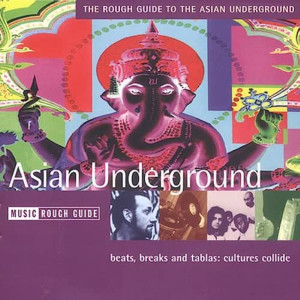 Inigo Jones wrote this review.
Inigo Jones wrote this review.
Featuring some of the best-known names in the Asian Underground – Ananda Shankar, Joi, Asian Dub Foundation – and a number of lesser known acts, Rough Guide’s latest compilation dares to compete with what must be the essential guide to the scene, the legendary 1997 Talvin Singh Presents Anokha – The Soundz of the Asian Underground. By focusing on the output of friendly rival label Nation Records, compiler DJ Ritu chose to complement rather than compete, and this album serves to fill out the historical record of the emergence of one of the most interesting music scenes today.
Ananda Shankar’s opening track “Streets of Calcutta” pulls out all the stops in a grand scale, Bollywood-inspired assault reminiscent of the British big beat sound of acts like Fatboy Slim. The drum and bass flavors of State Of Bengal’s “Elephant Ride” effortlessly bridge the distance between east and west, traditional tabla playing and high-tech sounds. Fun-Da-Mental’s “Ja Sha Taan” is based on the Qawwali song, and fans of Nusrat Fateh Ali Khan will be familiar with the tune and its haunting refrain, recorded as “Mustt Mustt” (Breakdown RealWorld, 1991). Though the production values are somewhat muddy, the soaring vocal performances by Nazawish Ali Khan and the pounding rhythms give this song more passion than the preceding cuts. The 1993 remix of Uzma’s “Yab Yum” by dance music polymath Andrew Weatherall (AKA Sabres of Paradise) builds a sound that is equal parts trance-inducing electronic pulse and barely recognizable tabla patterns, peppered with a few moments of dub-inspired horns, creating a work that is equally ready for the dance floor or the living room.
The tarana singing that opens Shivanova’s “Sundance” is often a precursor to blindingly fast tabla solos, and this track combines a twisting horn line with steadily building polyrhythms, but instead of a blast of white light, we get some midtempo tarana singing followed by a few tabla flourishes. Despite pulling its punches, it’s a nice cut, and definitely representative of the genre. The obligatory Asian Dub Foundation track, “Debris,” is from their first and best album Facts and Fictions (1995). Perhaps the most fascinating, and probably the most commercially successful act in the Asian Underground scene, the ADF has a distinct hip-hop sensibility, with elements of Rage Against the Machine and the Beastie Boys toughening up their breakbeat east/west fusion.
TJ Rehmi’s “Is It Legal?” is a bizarre mix, pushing the incongruities of the mixed genres to the forefront, and rather than blending the sounds, the song actually alternates between them. This results in some interesting moments, creating a loose line of cause and effect that is one of the more unique sensibilities at work on the album. However, this is a qualified endorsement, as there is a sense that the artist is mocking the audience he courts, forcing them to confront the most clichéd aspects of the genre but without much humor. This strategy is achieved more successfully by Mo Magic on their “Mixed Vision” track, which blurs the line between traditional and avant-garde by taking the original acoustic drum sounds and filtering them almost to the edge of recognizability. James Asher’s uplifting “Nataraj Express” contains elements of the Goa trance sound, an interesting parallel movement which emerged simultaneous to the London-based Asian Underground from the mid-90s on. Here the blend is distilled to its essence – the huge synth washes are propelled forward by furious drumming, while the vocalist sings Hindi love lyrics and the sun rises over the beach…
Overall, a few themes emerge – a love of the sound of old records and scratchy radios playing traditional music; translation of Indian classical and pop styles onto electronic music and vice versa; a more than passing nod to reggae and dub; delicate instruments like flutes, violins and sarods – both live and sampled – floating over clattering drum & bass beats. The Rough Guide mines the considerable vaults of scenemakers Nation Records, and adds some more recent additions from new and known talent. While it may not contain anything as inspired as the Anokha album’s “Welcome to India Airlines Flight IC-408,” it is full of quality music and is suitable for repeated listenings.
(World Music Network, 2003)
